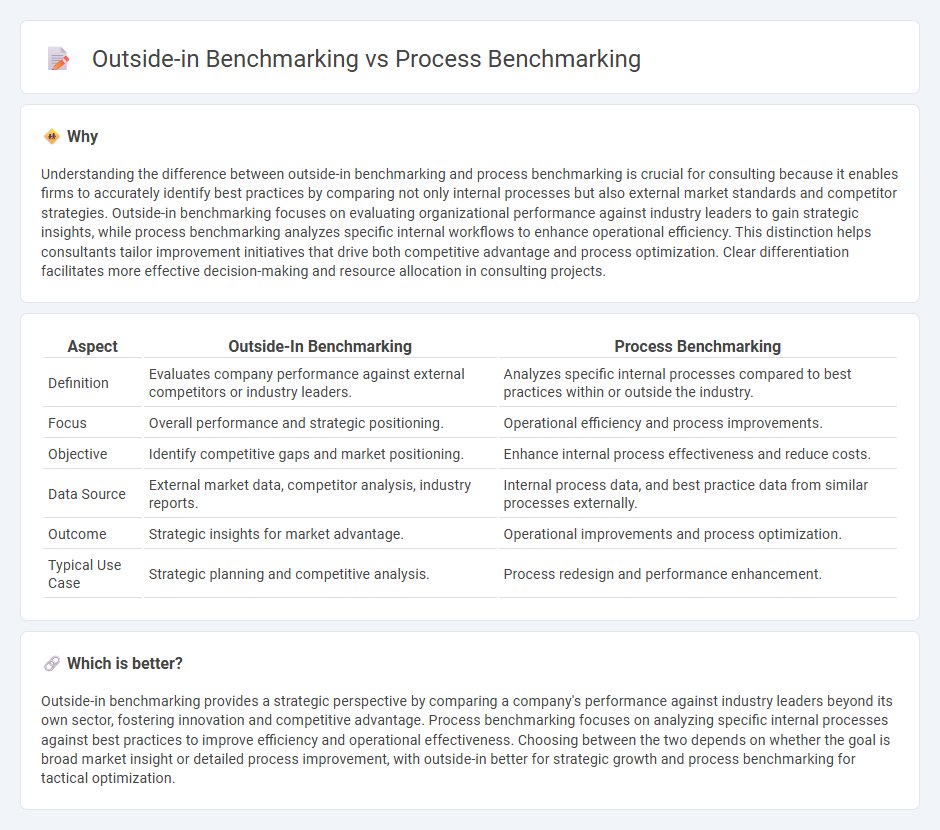
Outside-in benchmarking involves comparing an organization's performance and practices against industry leaders and competitors, focusing on external market standards to identify best practices. Process benchmarking examines specific internal processes by measuring them against those of top performers to enhance operational efficiency and effectiveness. Explore how these benchmarking approaches can transform your consulting strategy for optimized results.
Why it is important
Understanding the difference between outside-in benchmarking and process benchmarking is crucial for consulting because it enables firms to accurately identify best practices by comparing not only internal processes but also external market standards and competitor strategies. Outside-in benchmarking focuses on evaluating organizational performance against industry leaders to gain strategic insights, while process benchmarking analyzes specific internal workflows to enhance operational efficiency. This distinction helps consultants tailor improvement initiatives that drive both competitive advantage and process optimization. Clear differentiation facilitates more effective decision-making and resource allocation in consulting projects.
Comparison Table
| Aspect | Outside-In Benchmarking | Process Benchmarking |
|---|---|---|
| Definition | Evaluates company performance against external competitors or industry leaders. | Analyzes specific internal processes compared to best practices within or outside the industry. |
| Focus | Overall performance and strategic positioning. | Operational efficiency and process improvements. |
| Objective | Identify competitive gaps and market positioning. | Enhance internal process effectiveness and reduce costs. |
| Data Source | External market data, competitor analysis, industry reports. | Internal process data, and best practice data from similar processes externally. |
| Outcome | Strategic insights for market advantage. | Operational improvements and process optimization. |
| Typical Use Case | Strategic planning and competitive analysis. | Process redesign and performance enhancement. |
Which is better?
Outside-in benchmarking provides a strategic perspective by comparing a company's performance against industry leaders beyond its own sector, fostering innovation and competitive advantage. Process benchmarking focuses on analyzing specific internal processes against best practices to improve efficiency and operational effectiveness. Choosing between the two depends on whether the goal is broad market insight or detailed process improvement, with outside-in better for strategic growth and process benchmarking for tactical optimization.
Connection
Outside-in benchmarking and process benchmarking are connected through their shared goal of improving organizational performance by analyzing external best practices and comparing internal processes. Outside-in benchmarking provides insights into how competitors and industry leaders operate, while process benchmarking focuses on evaluating and refining specific workflows within the organization. This integration enables companies to adopt proven strategies and optimize processes for enhanced efficiency and competitive advantage.
Key Terms
Best Practices
Process benchmarking centers on comparing internal workflows against top performers within the same industry to identify efficiency and quality improvements. Outside-in benchmarking broadens this scope by evaluating best practices from leading organizations across different industries to inspire innovative strategies. Explore how leveraging both approaches can drive superior business performance and continuous improvement.
Competitive Analysis
Process benchmarking concentrates on comparing internal processes against industry leaders to identify performance gaps and best practices, enhancing operational efficiency. Outside-in benchmarking emphasizes competitive analysis by examining competitors' customer experiences, market positioning, and strategic initiatives to gain external insights. Discover more about how these benchmarking methods drive strategic advantage and business growth.
External Comparison
Process benchmarking concentrates on evaluating internal processes by comparing them with industry best practices to identify performance gaps. Outside-in benchmarking emphasizes an external comparison by analyzing competitors' customer experiences and market positioning to enhance strategic decisions. Explore detailed insights on how these benchmarking approaches drive business improvements.
Source and External Links
Process Benchmarking - The Hackett Group(r) - Process benchmarking is a method to evaluate an organization's operational performance against peers and industry leaders to identify areas for improvement and justify business case initiatives.
Benchmarking - Wikipedia - Process benchmarking involves comparing business processes and performance metrics to best practices from leading companies, aiming to improve performance continuously.
8 Steps of the Benchmarking Process - This approach defines a detailed process for benchmarking, including selecting critical processes, identifying comparison organizations, documenting current processes, and gathering and analyzing comparative data.
 dowidth.com
dowidth.com